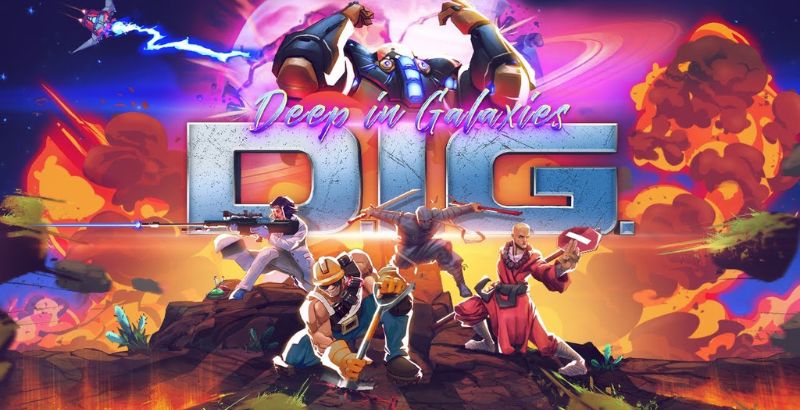
When you’re liberating a galaxy from an oppressive overlord, you can expect to explore dozens of planets in your quest. Unfortunately for DIG – Deep in Galaxies, when you’ve seen one, you’ve seen them all. DIG – Deep in Galaxies is an action roguelike platformer from developer Molton Studio and publisher Raiser Games. But despite some promising mechanics and catchy music, DIG – Deep in Galaxies proves that some ideas should not get clearance for takeoff.
After a highly light premise is established, players take the role of a civilian who is sick and tired of the Overlord’s digging ships destroying their planet, so they decide to fight back. Unfortunately, this opening cutscene makes up most of the story delivered to the player, so if you were hoping to find a gripping narrative, you won’t find it here.
Initially, there is a single character class to pick from, but others are unlocked through gameplay, each with unique passive bonuses and starting equipment. However, most of these characters felt like half-baked ideas, like the bomber who—you guessed it—blows things up! Their equipment protects them from explosions but it’s a bonus that rarely comes into play since their own super ability (a massive explosion) can’t hurt them anyway. Another character, the scientist, grows stronger through the use of potions. Still, once again, I found myself unable to fully enjoy the character’s intended playstyle because of how infrequently I found potions. In fact, in my time with the game, I only enjoyed playing as the monk. They had what felt like the only cohesive load out, with their super ability allowing them to charge into enemies for damage and refilling their super meter whenever they got a kill. Combined with their equipment and passives, this character felt like the best execution of the developer’s ideas. The monk made the game more enjoyable, although admittedly, it wasn’t by much.
Like many a roguelike, DIG – Deep in Galaxies provides endless replayability in the form of randomized planets to liberate from the evil Overlord. Some objectives are straightforward, like “Destroy the Mutant Wasp Nest” or “Save the Wounded Doctor.” Though randomized, these planets will feature a fairly large area dedicated to your objective, like a cavernous space to fight the wasp nest or an impenetrable building from which to rescue the wounded doctor. Then there are some objectives like “Destroy 7 Lava Flowers,” “Kill the Crawlers,” or “Stop the Abusive Taxes.” Some of them are unclear on a surface level, while others leave you to roam around a large procedurally generated level, only marking a target when you’re close enough to see them anyway. Even with the more enjoyable objectives in mind, they can all be categorized as “kill something” or “find something;” variety is nearly non-existent, which feels antithetical to a roguelike.
This monotony also extends to the planets themselves. Although there’s a whole map of worlds to explore, only a few have objectives that grant rewards, and even fewer stand out in any meaningful way. One level that did stand out was filled with water, with a mission to find a giant pearl, which was located in a building-like structure underwater. Otherwise, most of the planets were a blur of brown tunnels covered in slimes, wasps, and the occasional enemy soldier. The most fun I had was finding an asteroid flying by on the galaxy map because landing on it placed me into a jumping puzzle mini-level.
While they were more challenging to succeed in, I wish these jumping puzzles were part of the mission pool because the movement mechanics are the best part of DIG – Deep in Galaxies. Armed with a double jump and a grapple rope, you can zip past enemies and through entire levels, sometimes completing a “find something” objective in under thirty seconds. This is a bad thing since completing a level this way means skipping over better weapons, new passive abilities, healing items, or even gold with which to buy any of these things. This makes the game feel at odds with itself because instead of rewarding you for an excellent performance, you’re instead punished for not plundering the levels with a shovel and a fine-toothed comb.
In addition to the characters’ traversal abilities, they can use their melee weapon as a digging tool, breaking through the levels’ many floors, walls, and ceilings to get to their objective. Sometimes I found gold or diamonds, but more often than not, I simply skipped over them because it immediately became tedious, like digging through the cushions of every couch you see in pursuit of lost change. Digging also felt unnecessary since most levels were laden with numerous paths snaking through the randomly generated chambers. Only once did I feel like digging was more than a novelty; even that didn’t save it from feeling like an unjustified addition.
The roguelike genre feels saturated with games that provide endless variety but with very little substance, and DIG – Deep in Galaxies feels like another unfortunate addition to the list. It gives a few highs, but they get lost somewhere after the fifth repetitive objective on the fifth identical-looking planet.
DIG – Deep in Galaxies leaves early access on Steam on February 16th.
DIG - Deep in Galaxies
-
Rating - 5.5/105.5/10
TL;DR
The roguelike genre feels saturated with games that provide endless variety but with very little substance, and DIG – Deep in Galaxies feels like another unfortunate addition to the list. It gives a few highs, but they get lost somewhere after the fifth repetitive objective on the fifth identical-looking planet.







